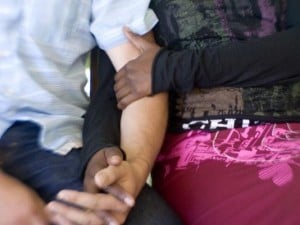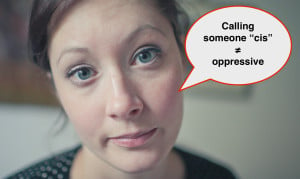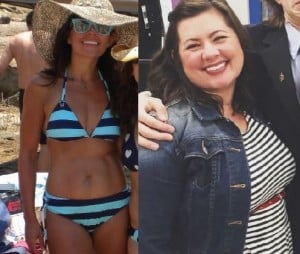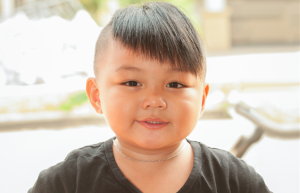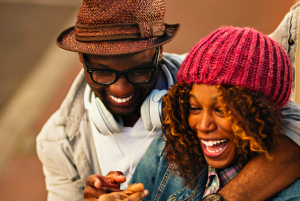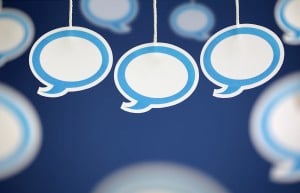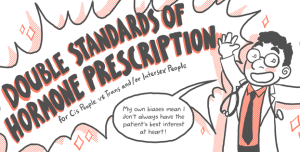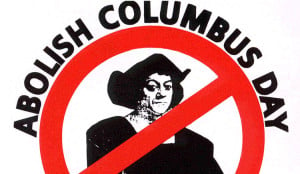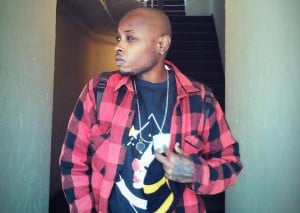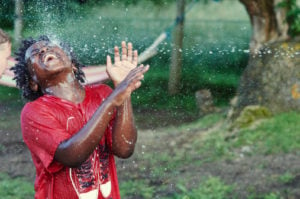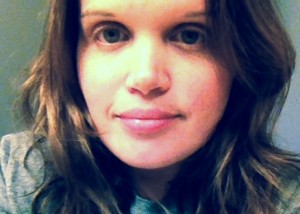
Source: Autostraddle
Originally published on Autostraddle and cross-posted here with their permission.
I was climbing the stairs of my elementary school shortly after the summer holidays, when I felt a hard smack against my sunburned back. I recall the sting and the boy who ran past me saying “gimp.”
I was very confused. I’d never heard this word before and didn’t know what it implied. I knew that he’d said it with disgust and the slap had meant to hurt.
I’d been taking the stairs one at a time, with my stronger leg leading, as I was apt to do. He’d seen this and became impatient, or he simply wanted to exert power over me. It was the first time I began to think I may not look like the other children.
I went home and stood in front of the hall full length mirror. I walked toward it and was shocked. My whole body moved from side to side as I took each step like the wobble of an Oompa Loompa from Willy Wonka & The Chocolate Factory.
Had this always been happening? How had I not noticed before? How come no one had told me?
My cheeks flamed red with shame. I didn’t mention it to anyone.
I am a person with restricted growth (or little person or person with dwarfism), and I am queer. I was born with a rare condition that causes my bones and joints to form differently and has reduced my height to a compact 4’5″.
I didn’t come out as queer until I was in my 30s. People asked me why it took so long. I come from a liberal family. I live in a mostly queer-friendly city in Canada, where we’ve had marriage equality for almost a decade.
However this doesn’t make me immune to the pervasive homophobia which still envelopes the majority of social and cultural spheres in my country and around the world.
But the deeper answer is that accepting my disabled identity was necessary before I could accept my queer one, and for me this has been a long, hard-fought struggle.
The disabled community uses the term “coming out” similarly to the GLBTQ community to signify when someone claims and accepts their identity as a disabled person, not in agreement with oppressive definitions of disability but as a valid and important part of their life experience.
For many of us, even though we may have been born with our impairments and they may be visible* to other people, accepting or even acknowledging this fundamental part of our lives is far from given.
I lived in denial for many years, a soul-destroying state as I’m constantly reminded of my physical differences or “abnormality” when dealing with the non-disabled world.
My denial was more than a resistance to accept my physical self but also a denial that these differences made me no less worthy than a non-disabled person.
I swallowed everything that was fed to me, every day. Every stare, every curious glance, every condescending remark, every negation of my autonomy and strength, built and affirmed a deep, seething self-loathing. This poison ran through my veins punishing me at every turn.
I had to actively deny that I existed at all to escape it.
Many disabled people are careful to keep these kinds of thoughts hidden and choose not to voice them. It’s an agreement of what the non-disabled world tells us over and over, that we so often contradict publicly as it quietly seeps under our skin.
The disabled narrative that the non-disabled world created wants to hear stories of “overcoming” my impairment, how I prove to everyone that I can do anything and everything they do. They want me to smile and be cheerful and grateful and use my disabled person’s “wisdom” to teach them about life and say trite things like, “The only disability in life is a bad attitude.”
Figure skater Scott Hamilton said that quote and I have no idea what context this came out of but no matter, it’s offensive and ridiculous. I’m disabled by the world in many ways and it has nothing to do with my bad attitude.
I identify as a disabled person. Some people may be uncomfortable with the fact that I put the word “disabled” before the word “person.” Our current climate of language asks that we use “people first” terminology to emphasize our humanity and to recognize that we are far more than our social labels or categories.
I agree wholeheartedly with the message using this order of terms sends. However, I believe in the social model of disability and under this view, I can’t have a disability because it exists outside of me.
The social model was developed in the mid-1970s by a group of disabled activists in the UK who wanted to politicize the social, economic and political oppression they experienced. They separated the concept of disability from an individual’s impairment, to remove the belief that a person’s specific condition — whether it is physical, sensory, intellectual or psychological — is the root cause of any limitations or ‘disabling’ barriers they encounter.
Instead they argued that “disability is something imposed on top of our impairment by the way we are unnecessarily isolated and excluded from full participation in society.”
Under this model, a person is disabled because social, cultural, and economic belief systems have been based on the idea that there is an “average” or “normal” human form and ways this form should function. The billions of people who have impairments or differences in their body or minds have been neglected to be included as part of the whole.
Other groups can certainly raise their hand as comrades in this form of social exclusion and discrimination (patriarchy anyone?). But what’s valuable to remember is that impairment crosses all sectors of human life, all gender identifications, all ethnicities, rich or poor, it’s a common and prevalent part of the collective human experience.
In fact one could argue it’s the most fundamental part of the human experience, in that we are all fallible, aging, vulnerable organisms.
It was in understanding this model that allowed me to truly comprehend what I’d swallowed. It was not simply that I faced barriers or was considered a “freak” but that my existence had been left out completely; no wonder I worked so hard to remain in denial.
I can’t pinpoint when things started to change for me. There was no cathartic revelation of self-worth or love. I was constantly exhausted, emotionally and physically, my spirit was eroded, and I became aware that I was going to collapse under it all.
Sobriety was the first step. Getting out of my head had been my primary objective and drugs and alcohol helped immensely in this pursuit. I had made my mind hostile to myself; it was a danger to me so I learned to escape it. Making it safe was essential to remove the desire to run away from it.
One of the harshest realities I’ve faced is when I stopped self-medicating and looked at myself, mentally and physically, really and truly for the first time. The anguish was indescribable but behind it was a strange sensation; it started slowly at first, a tiny inkling in the back of my mind. After it grew stronger I recognized it as a feeling of freedom, the slightest possibility that I could be at peace with myself.
It soon became clear to me that by coming to terms with being disabled I could also declare and celebrate being queer. I’d spent years straddling the line between in and out. I was unable to step over this line because it required an acceptance of self I did not possess.
I kept my queer identity at bay because to take it on would’ve broken me. Possessing it meant I could no longer ignore the other parts that are fundamental to my identity and being queer is one of these fundamental parts.
People sometimes suggest that the GLBTQ community is more accepting of diversity and acknowledging the struggles of other oppressed minorities. Like many people, I find this is more rhetoric than reality.
The same prejudice the non-disabled world places on disabled people is alive and well among many queer people and in queer spaces.
Being queer doesn’t help me accept being a disabled person. In fact it’s the reverse: being disabled, or the recognition of this, allows me to accept and ultimately celebrate being queer.
Disabled people are sometimes asked, “If you had a choice, would you choose to be a non-disabled person?” This question is inherently oppressive; underneath it there’s the insidious and softly whispered belief that “we are better dead than disabled.”
I used to refuse to contemplate this question; it was laden with what I feared of myself the most, that I’d like to extinguish my existence altogether. But here’s the answer I have worked so hard to not only give, but believe, and then live by. Yes, I would choose it. Being disabled, being queer. I would choose me.
The broken parts that can’t be put back together, the angry parts, the parts that are in pain, the parts that are rejected, the parts that go unnoticed, and the parts that despair. I would choose it all, every time.
I’ve never liked the term “to overcome” which is so often used when we speak of adversity, as if one could vanquish all barriers if only one is strong enough. Instead the term “to make peace” has always resonated with me.
Making peace for me was about laying down my sword in the battle against myself. To stop perceiving myself through a filtered lens of what I should’ve been or how others may see me. And to also recognize that I’ll never stop encountering prejudice and barriers and rejection, but that I can channel the energy that I’d wasted on destroying myself in other more powerful ways. I still have a lot of fight in me.
The other day I saw a glimpse of myself as I walked past a mirror. I momentarily reacted as I would have years ago, feeling a rise of shame and a sinking feeling of sadness.
Then I found myself saying, “I thought you had made peace with that,” and then I remembered I had, and kept going.
***
*I would like to acknowledge that some terminology used in this essay can be considered exclusive of some people’s physical, sensory, psychological and intellectual experiences. As well that my personal lived experiences and beliefs are not necessarily shared, nor can they be extrapolated to any other disabled person.
[do_widget id=”text-101″]
Want to discuss this further? Visit our online forum and start a post!
Lesley lives in Vancouver BC Canada, works in fundraising and identifies as queer and disabled. She recently completed her Masters in Critical Disability Studies and is passionate about the rights of disabled people. When not working or studying you can find her binge watching Netflix, swimming or getting on long plane rides to far off destinations.
Search our 3000+ articles!
Read our articles about:
Our online racial justice training
Used by hundreds of universities, non-profits, and businesses.
Click to learn more
Most Read Articles
- « Previous
- 1
- …
- 30
- 31
- 32





